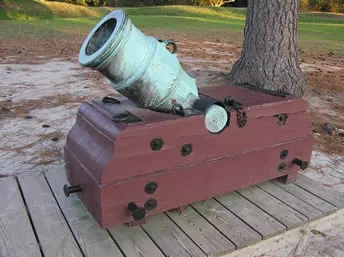“He hobbled into battle on his wooden leg”
Jacob Chapman’s 1882 Genealogy of the Folsom Family: John Folsom and His Descendants, 1615-1882 devoted an apprendix to Jonathan Folsom, sharing this bit of family lore:
No American veterans described a man with one leg amputated above the knee joining the fight. Nathaniel Folsom didn’t mention his brother in the letters he sent back to New Hampshire.
No British naval sources complained about provincial mortar fire or blamed a shell for pulling back from the battle.
One source for this tale, if not the only one, was Jonathan Folsom’s granddaughter Betsey, born in 1792. She could have known her grandfather directly since he died around 1800. Betsey Folsom married a man named Daniel Durgin and then outlived him by three decades, dying in 1878. Her son Mark William Franklin Durgin of Medford appears to have been one of Chapman’s sources on the family.
After the Chapman book, the story of Jonathan Folsom firing a mortar at Bunker Hill appeared in a few publications of the Sons of the American Revolution. Though Lt. Folsom’s service in the French & Indian War was well documented, descendants joining that organization needed to say he fought in the next war as well.
TOMORROW: Versifying.
when the Revolutionary war commenced, he set out for another campaign, and found his way to Bunker Hill. Here he hobbled into battle on his wooden leg, and took charge of a mortarThere’s no supporting evidence for this story. No other American account says the provincial forces at Bunker Hill had a mortar. (They had six four-pounder cannon, though only one trained gun crew at the height of the battle.)
It is said that at the second shot he threw a bomb upon the deck of a British man-of-war, which led her to draw off as soon as possible into safer quarters.
No American veterans described a man with one leg amputated above the knee joining the fight. Nathaniel Folsom didn’t mention his brother in the letters he sent back to New Hampshire.
No British naval sources complained about provincial mortar fire or blamed a shell for pulling back from the battle.
One source for this tale, if not the only one, was Jonathan Folsom’s granddaughter Betsey, born in 1792. She could have known her grandfather directly since he died around 1800. Betsey Folsom married a man named Daniel Durgin and then outlived him by three decades, dying in 1878. Her son Mark William Franklin Durgin of Medford appears to have been one of Chapman’s sources on the family.
After the Chapman book, the story of Jonathan Folsom firing a mortar at Bunker Hill appeared in a few publications of the Sons of the American Revolution. Though Lt. Folsom’s service in the French & Indian War was well documented, descendants joining that organization needed to say he fought in the next war as well.
TOMORROW: Versifying.


2 comments:
Another great article. I was at the Bunker Hill Cornerstone Rededication June 16, about a month ago. I can imagine the action going on still. You can almost feel it, or you can. I wonder if you've considered coming to talk to some Masons or other groups interested in your blog, your book, your work. I bet it would be a great time. I'm sure it would include a dinner. Just speculating, but I can see a good connection. I hope this message finds you well. Ah. I'm Nathan Lee (not a Nathan, but Nathan Lee) - quite like an anagram with colel (a term you may wish to discover) from Nathaniel - Nathan Lee... so - thank you, and have a great day!
I speak to many history-minded groups when our schedules mesh. The Massachusetts Grand Lodge hosted a symposium on the Boston Tea Party in December 1773, and I had the honor of being there.
Post a Comment